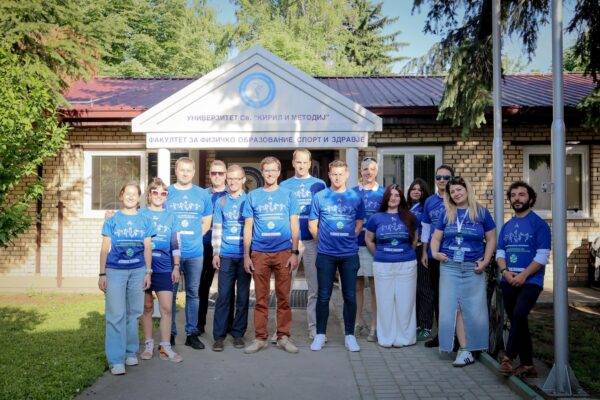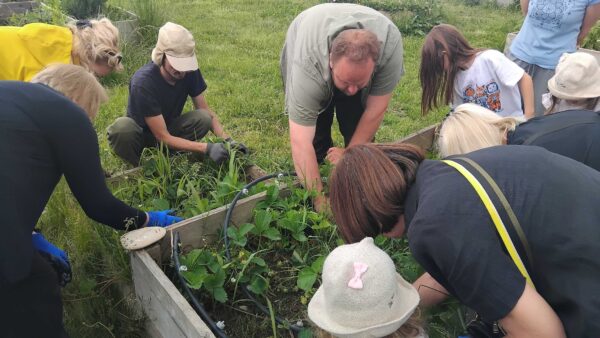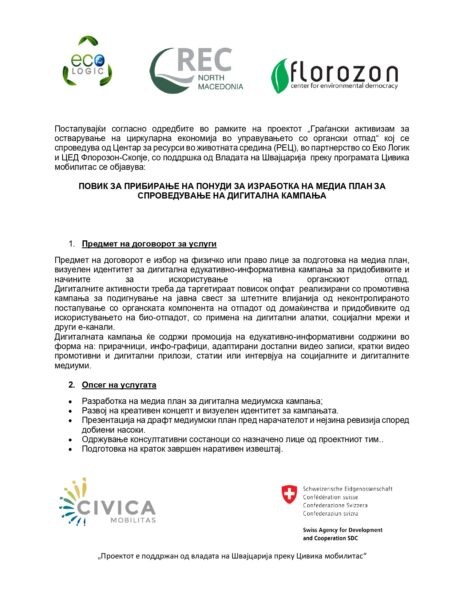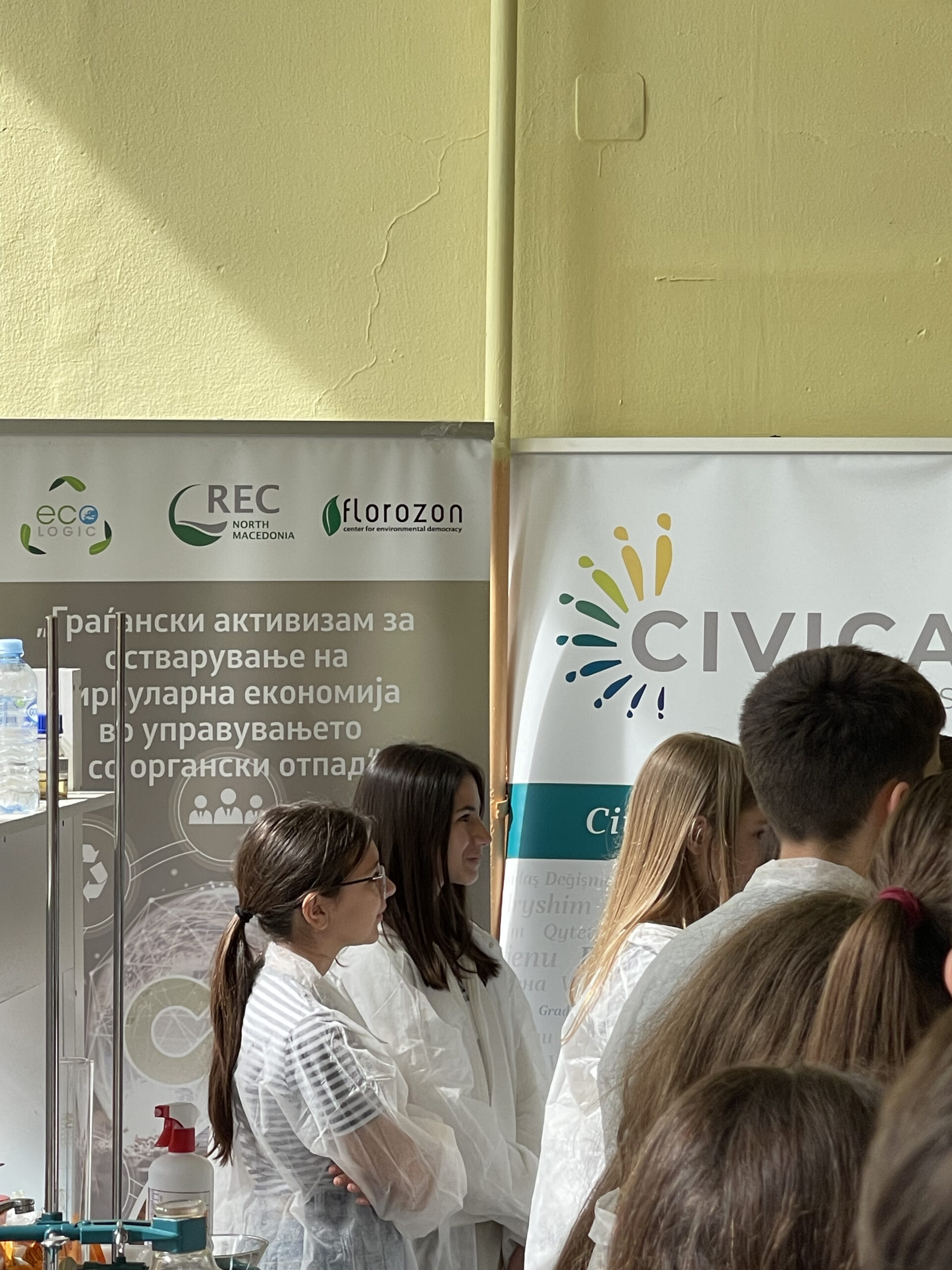Newsletter #3
Project RIDE AND SMILE
After the summer season, we are back in the full workflow of the RIDE
AND SMILE project – but this time to show off some of the important
statistics we received over the course of the last few months. We intend
on enriching the content of the project website, exactly with the newest
information we collected, all presented below…
To arrive at the next stages in the project, and collect information for our updates, we have
relied on the valuable answers and opinions provided by the teachers and parents of chil-
dren ages 7-12. Mainly, as we mentioned in the previous newsletter edition, we created and
conducted surveys on a national level, exploring the general cycling infrastructure of each
partner country, as well as tackling the topic of digital literacy among children.
We asked parents and teachers about cycling and tech-use…
If we want to bring about certain positive changes in society, the very least we can do is have
an interest in some challenging issues, and of course, have an idea of how to take the initia-
tive toward the goals. Since our main focus is promoting cycling among children, it goes
without saying that the infrastructure in each partner country is of major importance for our
project activities.
With the infrastructure in mind, there were several crucial questions aimed for the parents
and teachers, such as whether the areas in each location/country allows for good cycling
conditions, are those conditions safe for the children with their bicycles and so on.
What did we need to discover for the cycling infrastructure?
Since our project involves using a digital web platform closely connected to the cycling
activities that will follow, it was crucial to find out what kind of access children have to tech
gadgets and devices; whether they know how to use these and how well for that matter too.
This was vital because our interactive platform will be based on inserting the progress
stages and points of the cycling activities, collecting and exchanging of experiences
between the platform users (pupils, teachers and educators, parents/guardians).
What did we need to discover for the digital literacy of children?
This project has been funded with support from the European Commission. This newsletter reflects the views
only of the authors, and the Commission cannot be held responsible for any use which may be made of the
information contained therein.
This project has been funded with support from the European Commission. This newsletter reflects the views
only of the authors, and the Commission cannot be held responsible for any use which may be made of the
information contained therein.
In Italy, a total of 51 parents have taken the survey, and all of them are from the urban
Rome area and central or semicentral neighborhoods.
Most of the pupils go to school driven by car, as the majority of respondents said (62.7%),
but this was also followed by 35% of respondents that said almost half of the children
can go by foot without any issues, sometimes supervised by adults of course, as 23.5%
confirmed the last one. The percentage of children that cycle to school is just 5.9%, but
quite similar to the number of those using the bus (3.9%). When it comes to the weather,
the changes in weather do not affect how the children go to school daily.
The distance from home to school is luckily not too vast with approximate 1km on aver-
age for almost all, with some exceeding between 1 and 3 km, and a little percentage of
23.5% having a distance larger than 3km. While in the route context, the safety factor is
a bit concerning in terms that almost a half of respondents (45.1%) think the roads are
significantly dangerous in general from a traffic point of view. Also, it is not very common
in Italy for pupils to go alone to school and 76% of respondents always accompany their
children to school, and the main reasons are the big distance from home to school and
possible road risks. It is almost the same after classes, a similar percentage of parents
always seek supervision for their children’s leisure activities.
The good news is that almost every child (92.2%) owns a bicycle and at least this is not
an issue among all things, but even despite this, almost a half (43.1%) do not cycle on a
daily basis, and just one third of them all use the bicycle a small number of times per
year, respectively, when it comes to leisure cycling, 39.2% do this a few times per month.
The main reason for the majority, on why children do not cycle to school is the lack of
safe infrastructure and roads, and it has less to do with the distance itself.
The digital usage aspect is as expected and assumed, with most using a smartphone,
and 31.4% do not use it at all. In turn, the tablet and laptop use shows much higher num-
bers, with almost every single child (98%) using these devices.
Hopefully, all of these numbers in total, so far, change for the better over time, since a
good number of 88.2% respondents would like the promotion of sustainable mobility in
the respective cities.
In the Republic of North Macedonia, a total of 329 teachers and 1260 parents have taken
the survey, from various urban, as well as rural areas too. The average class size is
around 20+ pupils, and most of them go to school by foot, whereas significantly less go
by bicycle, car, bus, and only less than 10 of them actually cycle to school – regardless
of weather conditions. The car is still a popular method for most, and 40% of them are
driven to school. The relieving thing is that the distance from homes to schools is not
too big and is approximately from 500m to 1km on average.
What answers did the surveys for teachers and parents show us precisely? Also, when it comes to owning a bicycle, the majority of teachers said that around 10
children per class do own one, and only a very small number of pupils do not have a
bicycle at all. When safety was emphasized, there were some issues, but not major and
most of the children go to school unattended – even with this in mind, cycling for leisure
could be more popular and it’s still not a primary transport method. Overall, the infra-
structure was the clear and obvious obstacle for lack of children cycling to school – lack
of proper paths and bicycle parking racks.
The digital tech usage and literacy in general, even though not a major issue, shows
some room for improvement – on average 40% of teachers said that circa half of the
class pupils use smartphones, laptops and/or tablets, with a good promising number
that almost every child knows how to use such devices, with an exception of a few.
Then, in Romania, the survey was taken by 5 teachers in total who took a keen and close
interest in the cycling habits of their pupils. The unanimous answer was that the majority
of pupils are walking to school on a daily basis, as a primary method of reaching their
destination. This was followed by those that cycle, in a smaller number than those walk-
ing by foot, and lastly, the least number of all children/pupils go to school by car (they
are driven to school, but this percentage is quite low) – these facts do not change much
even with weather changes.
The numbers in general, also similarly to the others’ presented, allow for improvements
regarding raising the awareness and popularity of cycling; in terms of the fact that
almost every teacher (80%) have undoubtedly claimed just 5 pupils cycle to school,
based on the ratio of an average class size. On the other hand, not many children live
close to the school, or 40% are further from the school location and therefore need to
be driven by car, even if they do own bicycles – on average the distance between home
and school is between 1 and 3 km.
When it comes to the safety factor, or going to school unsupervised by an
adult/parent/guardian, it is not surprising to know that the older pupils are able to go
unsupervised, whereas those younger need parental/guardian accompanying (or go
with their older siblings). The main reason for accompanying is the personal fears par-
ents have, followed by habitual daily commuting and protection from stray dogs as well.
Outside of school though, for cycling for leisure, the bicycle is used on average just a
few times per week. The main reasons for not cycling regularly are the safety within the
infrastructure/roads (they could be improved), but the distance from home to school
also played a big role, followed by weather and cultural reasons as last.
The other major factor of the survey, digital literacy of children for smartphones, tablets
and laptops showed that most of the children have smartphones and they use them
quite a lot on a daily basis as well, to the point of well-skilled working and tech-knowl-
edge, along the computer use level quite similar as well.
This project has been funded with support from the European Commission. This newsletter reflects the views
only of the authors, and the Commission cannot be held responsible for any use which may be made of the
information contained therein.
In Italy, a total of 51 parents have taken the survey, and all of them are from the urban
Rome area and central or semicentral neighborhoods.
Most of the pupils go to school driven by car, as the majority of respondents said (62.7%),
but this was also followed by 35% of respondents that said almost half of the children
can go by foot without any issues, sometimes supervised by adults of course, as 23.5%
confirmed the last one. The percentage of children that cycle to school is just 5.9%, but
quite similar to the number of those using the bus (3.9%). When it comes to the weather,
the changes in weather do not affect how the children go to school daily.
The distance from home to school is luckily not too vast with approximate 1km on aver-
age for almost all, with some exceeding between 1 and 3 km, and a little percentage of
23.5% having a distance larger than 3km. While in the route context, the safety factor is
a bit concerning in terms that almost a half of respondents (45.1%) think the roads are
significantly dangerous in general from a traffic point of view. Also, it is not very common
in Italy for pupils to go alone to school and 76% of respondents always accompany their
children to school, and the main reasons are the big distance from home to school and
possible road risks. It is almost the same after classes, a similar percentage of parents
always seek supervision for their children’s leisure activities.
The good news is that almost every child (92.2%) owns a bicycle and at least this is not
an issue among all things, but even despite this, almost a half (43.1%) do not cycle on a
daily basis, and just one third of them all use the bicycle a small number of times per
year, respectively, when it comes to leisure cycling, 39.2% do this a few times per month.
The main reason for the majority, on why children do not cycle to school is the lack of
safe infrastructure and roads, and it has less to do with the distance itself.
The digital usage aspect is as expected and assumed, with most using a smartphone,
and 31.4% do not use it at all. In turn, the tablet and laptop use shows much higher num-
bers, with almost every single child (98%) using these devices.
Hopefully, all of these numbers in total, so far, change for the better over time, since a
good number of 88.2% respondents would like the promotion of sustainable mobility in
the respective cities.
In the Republic of North Macedonia, a total of 329 teachers and 1260 parents have taken
the survey, from various urban, as well as rural areas too. The average class size is
around 20+ pupils, and most of them go to school by foot, whereas significantly less go
by bicycle, car, bus, and only less than 10 of them actually cycle to school – regardless
of weather conditions. The car is still a popular method for most, and 40% of them are
driven to school. The relieving thing is that the distance from homes to schools is not
too big and is approximately from 500m to 1km on average.
Also, when it comes to owning a bicycle, the majority of teachers said that around 10
children per class do own one, and only a very small number of pupils do not have a
bicycle at all. When safety was emphasized, there were some issues, but not major and
most of the children go to school unattended – even with this in mind, cycling for leisure
could be more popular and it’s still not a primary transport method. Overall, the infra-
structure was the clear and obvious obstacle for lack of children cycling to school – lack
of proper paths and bicycle parking racks.
The digital tech usage and literacy in general, even though not a major issue, shows
some room for improvement – on average 40% of teachers said that circa half of the
class pupils use smartphones, laptops and/or tablets, with a good promising number
that almost every child knows how to use such devices, with an exception of a few.
Then, in Romania, the survey was taken by 5 teachers in total who took a keen and close
interest in the cycling habits of their pupils. The unanimous answer was that the majority
of pupils are walking to school on a daily basis, as a primary method of reaching their
destination. This was followed by those that cycle, in a smaller number than those walk-
ing by foot, and lastly, the least number of all children/pupils go to school by car (they
are driven to school, but this percentage is quite low) – these facts do not change much
even with weather changes.
The numbers in general, also similarly to the others’ presented, allow for improvements
regarding raising the awareness and popularity of cycling; in terms of the fact that
almost every teacher (80%) have undoubtedly claimed just 5 pupils cycle to school,
based on the ratio of an average class size. On the other hand, not many children live
close to the school, or 40% are further from the school location and therefore need to
be driven by car, even if they do own bicycles – on average the distance between home
and school is between 1 and 3 km.
When it comes to the safety factor, or going to school unsupervised by an
adult/parent/guardian, it is not surprising to know that the older pupils are able to go
unsupervised, whereas those younger need parental/guardian accompanying (or go
with their older siblings). The main reason for accompanying is the personal fears par-
ents have, followed by habitual daily commuting and protection from stray dogs as well.
Outside of school though, for cycling for leisure, the bicycle is used on average just a
few times per week. The main reasons for not cycling regularly are the safety within the
infrastructure/roads (they could be improved), but the distance from home to school
also played a big role, followed by weather and cultural reasons as last.
The other major factor of the survey, digital literacy of children for smartphones, tablets
and laptops showed that most of the children have smartphones and they use them
quite a lot on a daily basis as well, to the point of well-skilled working and tech-knowl-
edge, along the computer use level quite similar as well.
This project has been funded with support from the European Commission. This newsletter reflects the views
only of the authors, and the Commission cannot be held responsible for any use which may be made of the
information contained therein.
In Italy, a total of 51 parents have taken the survey, and all of them are from the urban
Rome area and central or semicentral neighborhoods.
Most of the pupils go to school driven by car, as the majority of respondents said (62.7%),
but this was also followed by 35% of respondents that said almost half of the children
can go by foot without any issues, sometimes supervised by adults of course, as 23.5%
confirmed the last one. The percentage of children that cycle to school is just 5.9%, but
quite similar to the number of those using the bus (3.9%). When it comes to the weather,
the changes in weather do not affect how the children go to school daily.
The distance from home to school is luckily not too vast with approximate 1km on aver-
age for almost all, with some exceeding between 1 and 3 km, and a little percentage of
23.5% having a distance larger than 3km. While in the route context, the safety factor is
a bit concerning in terms that almost a half of respondents (45.1%) think the roads are
significantly dangerous in general from a traffic point of view. Also, it is not very common
in Italy for pupils to go alone to school and 76% of respondents always accompany their
children to school, and the main reasons are the big distance from home to school and
possible road risks. It is almost the same after classes, a similar percentage of parents
always seek supervision for their children’s leisure activities.
The good news is that almost every child (92.2%) owns a bicycle and at least this is not
an issue among all things, but even despite this, almost a half (43.1%) do not cycle on a
daily basis, and just one third of them all use the bicycle a small number of times per
year, respectively, when it comes to leisure cycling, 39.2% do this a few times per month.
The main reason for the majority, on why children do not cycle to school is the lack of
safe infrastructure and roads, and it has less to do with the distance itself.
The digital usage aspect is as expected and assumed, with most using a smartphone,
and 31.4% do not use it at all. In turn, the tablet and laptop use shows much higher num-
bers, with almost every single child (98%) using these devices.
Hopefully, all of these numbers in total, so far, change for the better over time, since a
good number of 88.2% respondents would like the promotion of sustainable mobility in
the respective cities.
In the Republic of North Macedonia, a total of 329 teachers and 1260 parents have taken
the survey, from various urban, as well as rural areas too. The average class size is
around 20+ pupils, and most of them go to school by foot, whereas significantly less go
by bicycle, car, bus, and only less than 10 of them actually cycle to school – regardless
of weather conditions. The car is still a popular method for most, and 40% of them are
driven to school. The relieving thing is that the distance from homes to schools is not
too big and is approximately from 500m to 1km on average.
Also, when it comes to owning a bicycle, the majority of teachers said that around 10
children per class do own one, and only a very small number of pupils do not have a
bicycle at all. When safety was emphasized, there were some issues, but not major and
most of the children go to school unattended – even with this in mind, cycling for leisure
could be more popular and it’s still not a primary transport method. Overall, the infra-
structure was the clear and obvious obstacle for lack of children cycling to school – lack
of proper paths and bicycle parking racks.
The digital tech usage and literacy in general, even though not a major issue, shows
some room for improvement – on average 40% of teachers said that circa half of the
class pupils use smartphones, laptops and/or tablets, with a good promising number
that almost every child knows how to use such devices, with an exception of a few.
Then, in Romania, the survey was taken by 5 teachers in total who took a keen and close
interest in the cycling habits of their pupils. The unanimous answer was that the majority
of pupils are walking to school on a daily basis, as a primary method of reaching their
destination. This was followed by those that cycle, in a smaller number than those walk-
ing by foot, and lastly, the least number of all children/pupils go to school by car (they
are driven to school, but this percentage is quite low) – these facts do not change much
even with weather changes.
The numbers in general, also similarly to the others’ presented, allow for improvements
regarding raising the awareness and popularity of cycling; in terms of the fact that
almost every teacher (80%) have undoubtedly claimed just 5 pupils cycle to school,
based on the ratio of an average class size. On the other hand, not many children live
close to the school, or 40% are further from the school location and therefore need to
be driven by car, even if they do own bicycles – on average the distance between home
and school is between 1 and 3 km.
When it comes to the safety factor, or going to school unsupervised by an
adult/parent/guardian, it is not surprising to know that the older pupils are able to go
unsupervised, whereas those younger need parental/guardian accompanying (or go
with their older siblings). The main reason for accompanying is the personal fears par-
ents have, followed by habitual daily commuting and protection from stray dogs as well.
Outside of school though, for cycling for leisure, the bicycle is used on average just a
few times per week. The main reasons for not cycling regularly are the safety within the
infrastructure/roads (they could be improved), but the distance from home to school
also played a big role, followed by weather and cultural reasons as last.
The other major factor of the survey, digital literacy of children for smartphones, tablets
and laptops showed that most of the children have smartphones and they use them
quite a lot on a daily basis as well, to the point of well-skilled working and tech-knowl-
edge, along the computer use level quite similar as well.
And the last thing we did recently…
What we did just recently was the joint staff training event (2 – 5 November) in Salzburg,
Austria – our partner Paris-Lodron-Universitat-Salzburg (P.L.U.S.) where the progress so far
was discussed, with the teachers of partner countries as well. We have seen where we stand
with the O1 ILP (Interactive Learning Platform), its functionalities, features, and some special
emphasis on its advanced features as well. And, the focus was mostly on motivating teach-
ers, educators, and tutors toward a better pupil engagement, but foremost on activities to
be explored and created in the following period ahead.
For this, as well as other project updates, more in the next edition of RIDE AND SMILE news-
letter.
For more news in the meantime, follow us on our Facebook page.
Stay tuned!





